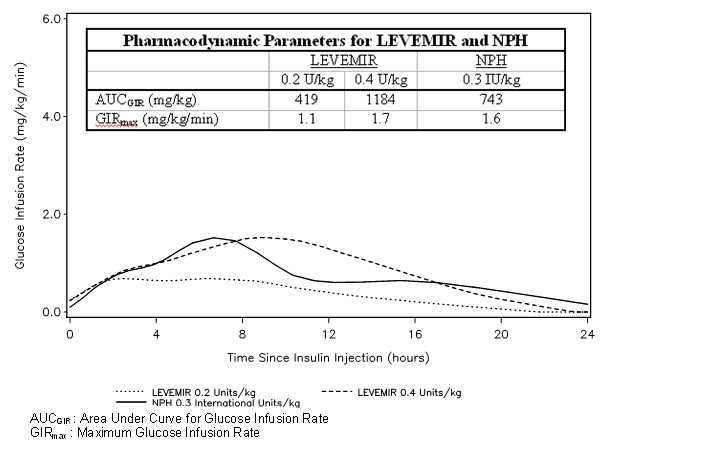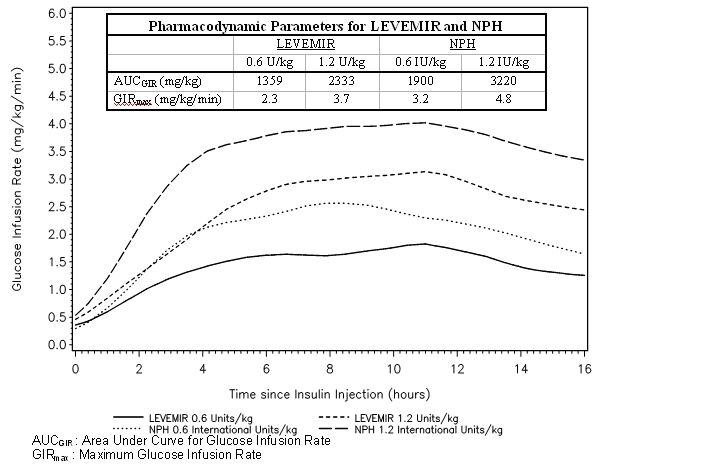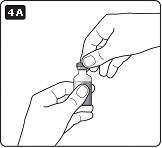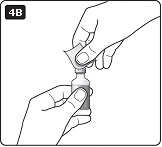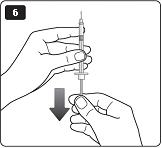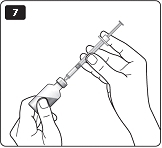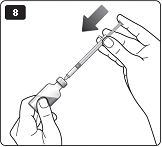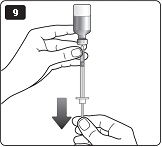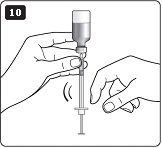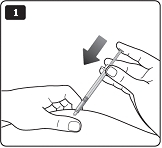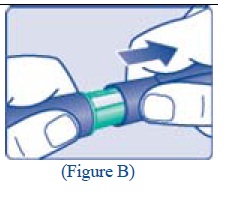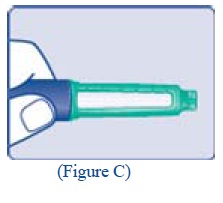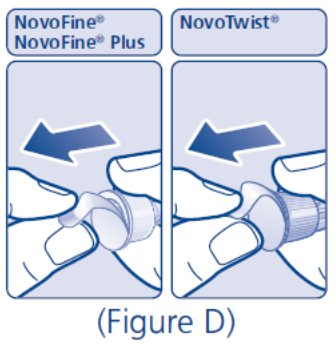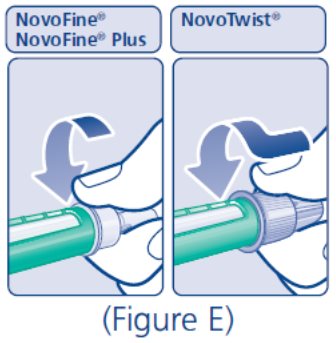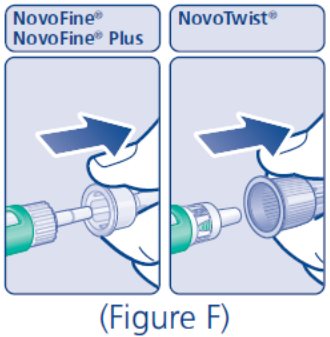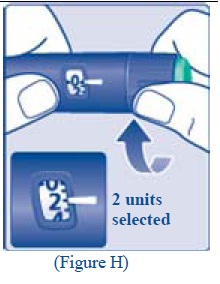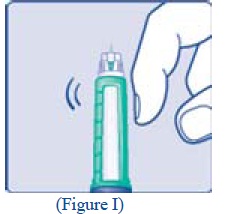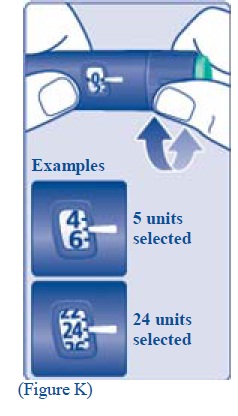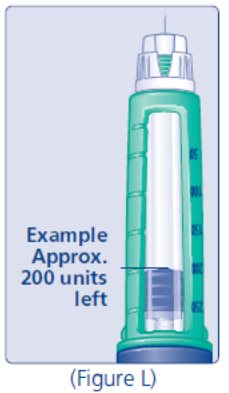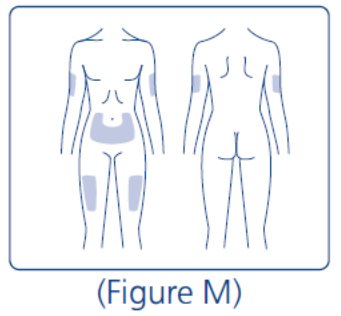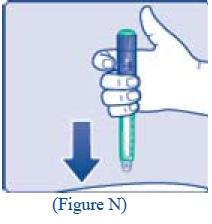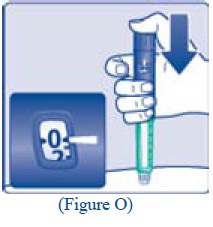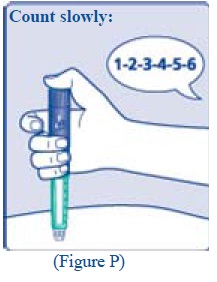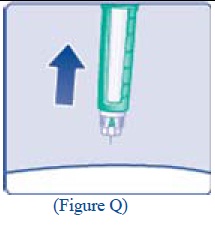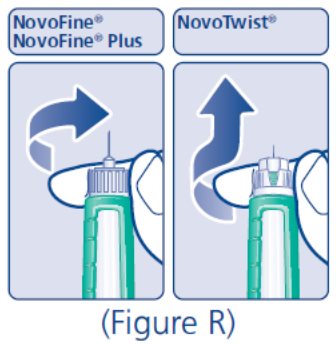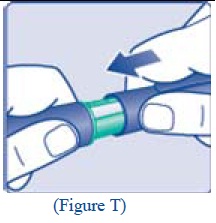LEVEMIR- insulin detemir injection, solution
Levemir by
Drug Labeling and Warnings
Levemir by is a Prescription medication manufactured, distributed, or labeled by REMEDYREPACK INC.. Drug facts, warnings, and ingredients follow.
Drug Details [pdf]
-
HIGHLIGHTS OF PRESCRIBING INFORMATION
These highlights do not include all the information needed to use LEVEMIR ® safely and effectively.
See full prescribing information for LEVEMIR.
LEVEMIR ® (insulin detemir [rDNA origin] injection) solution for subcutaneous injection
Initial U.S. Approval: 2005RECENT MAJOR CHANGES
Warnings and Precautions ( 5.1) 02/2015
INDICATIONS AND USAGE
LEVEMIR is a long-acting human insulin analog indicated to improve glycemic control in adults and children with diabetes mellitus. ( 1)
Important Limitations of Use:
- Not recommended for treating diabetic ketoacidosis. Use intravenous, rapid-acting or short-acting insulin instead.
DOSAGE AND ADMINISTRATION
- The starting dose should be individualized based on the type of diabetes and whether the patient is insulin-naïve ( 2.1, 2.2, 2.3)
- Administer subcutaneously once daily or in divided doses twice daily. Once daily administration should be given with the evening meal or at bedtime ( 2.1)
- Rotate injection sites within an injection area (abdomen, thigh, or deltoid) to reduce the risk of lipodystrophy ( 2.1)
- Converting from other insulin therapies may require adjustment of timing and dose of LEVEMIR. Closely monitor glucoses especially upon converting to LEVEMIR and during the initial weeks thereafter ( 2.3)
DOSAGE FORMS AND STRENGTHS
Solution for injection 100 Units/mL (U-100) in
- 3 mL LEVEMIR FlexTouch ®
- 10 mL vial ( 3)
CONTRAINDICATIONS
- Do not use in patients with hypersensitivity to LEVEMIR or any of its excipients ( 4)
WARNINGS AND PRECAUTIONS
- Never Share a LEVEMIR FlexTouch between patients, even if the needle is changed ( 5.1).
- Dose adjustment and monitoring: Monitor blood glucose in all patients treated with insulin. Insulin regimens should be modified cautiously and only under medical supervision ( 5.2)
- Administration: Do not dilute or mix with any other insulin or solution. Do not administer subcutaneously via an insulin pump, intramuscularly, or intravenously because severe hypoglycemia can occur ( 5.3)
- Hypoglycemia is the most common adverse reaction of insulin therapy and may be life-threatening ( 5.4, 6.1)
- Allergic reactions: Severe, life-threatening, generalized allergy, including anaphylaxis, can occur ( 5.5)
- Renal or hepatic impairment: May require adjustment of the LEVEMIR dose ( 5.6, 5.7)
- Fluid retention and heart failure can occur with concomitant use of thiazolidinediones (TZDs), which are PPAR-gamma agonists, and insulin, including LEVEMIR ( 5.9)
ADVERSE REACTIONS
Adverse reactions associated with LEVEMIR include hypoglycemia, allergic reactions, injection site reactions, lipodystrophy, rash and pruritus ( 6)
To report SUSPECTED ADVERSE REACTIONS, contact Novo Nordisk Inc. at 1-800-727-6500 or FDA at 1-800-FDA-1088 or www.fda.gov/medwatch
DRUG INTERACTIONS
USE IN SPECIFIC POPULATIONS
Pediatric: Has not been studied in children with type 2 diabetes. Has not been studied in children with type 1 diabetes < 2 years of age ( 8.4)
See 17 for PATIENT COUNSELING INFORMATION and FDA-approved patient labeling.
Revised: 10/2018
-
Table of Contents
FULL PRESCRIBING INFORMATION: CONTENTS*
1 INDICATIONS AND USAGE
2 DOSAGE AND ADMINISTRATION
2.1 Dosing
2.2 Initiation of LEVEMIR Therapy
2.3 Converting to LEVEMIR from Other Insulin Therapies
3 DOSAGE FORMS AND STRENGTHS
4 CONTRAINDICATIONS
5 WARNINGS AND PRECAUTIONS
5.1 Never Share a LEVEMIR FlexTouch Between Patients
5.2 Dosage Adjustment and Monitoring
5.3 Administration
5.4 Hypoglycemia
5.5 Hypersensitivity and Allergic Reactions
5.6 Renal Impairment
5.7 Hepatic Impairment
5.8 Drug Interactions
5.9 Fluid retention and heart failure with concomitant use of PPAR-gamma agonists
6 ADVERSE REACTIONS
6.1 Clinical Trial Experience
6.2 Postmarketing Experience
7 DRUG INTERACTIONS
8 USE IN SPECIFIC POPULATIONS
8.1 Pregnancy
8.3 Nursing Mothers
8.4 Pediatric Use
8.5 Geriatric Use
10 OVERDOSAGE
11 DESCRIPTION
12 CLINICAL PHARMACOLOGY
12.1 Mechanism of Action
12.2 Pharmacodynamics
12.3 Pharmacokinetics
13 NONCLINICAL TOXICOLOGY
13.1 Carcinogenesis, Mutagenesis, Impairment of Fertility
14 CLINICAL STUDIES
16 HOW SUPPLIED/STORAGE AND HANDLING
16.1 How Supplied
16.2 Storage
16.3 Preparation and Handling
17 PATIENT COUNSELING INFORMATION
17.1 Never Share a LEVEMIR FlexTouch Between Patients
17.2 Instructions for Patients
- * Sections or subsections omitted from the full prescribing information are not listed.
- 1 INDICATIONS AND USAGE
-
2 DOSAGE AND ADMINISTRATION
2.1 Dosing
LEVEMIR is a recombinant human insulin analog for once- or twice-daily subcutaneous administration.
Patients treated with LEVEMIR once-daily should administer the dose with the evening meal or at bedtime.
Patients who require twice-daily dosing can administer the evening dose with the evening meal, at bedtime, or 12 hours after the morning dose.
The dose of LEVEMIR must be individualized based on clinical response. Blood glucose monitoring is essential in all patients receiving insulin therapy.
Patients adjusting the amount or timing of dosing with LEVEMIR should only do so under medical supervision with appropriate glucose monitoring [see Warnings and Precautions (5.2)].
In patients with type 1 diabetes, LEVEMIR must be used in a regimen with rapid-acting or short-acting insulin.
As with all insulins, injection sites should be rotated within the same region (abdomen, thigh, or deltoid) from one injection to the next to reduce the risk of lipodystrophy [see Adverse Reactions (6.1)].
LEVEMIR can be injected subcutaneously in the thigh, abdominal wall, or upper arm. As with all insulins, the rate of absorption, and consequently the onset and duration of action, may be affected by exercise and other variables, such as stress, intercurrent illness, or changes in co-administered medications or meal patterns.
When using LEVEMIR with a glucagon-like peptide (GLP)-1 receptor agonist, administer as separate injections. Never mix. It is acceptable to inject LEVEMIR and a GLP-1 receptor agonist in the same body region but the injections should not be adjacent to each other.
2.2 Initiation of LEVEMIR Therapy
The recommended starting dose of LEVEMIR in patients with type 1 diabetes should be approximately one-third of the total daily insulin requirements. Rapid-acting or short-acting, pre-meal insulin should be used to satisfy the remainder of the daily insulin requirements.
The recommended starting dose of LEVEMIR in patients with type 2 diabetes inadequately controlled on oral antidiabetic medications is 10 Units (or 0.1-0.2 Units/kg) given once daily in the evening or divided into a twice daily regimen.
The recommended starting dose of LEVEMIR in patients with type 2 diabetes inadequately controlled on a GLP-1 receptor agonist is 10 Units given once daily in the evening.
LEVEMIR doses should subsequently be adjusted based on blood glucose measurements. The dosages of LEVEMIR should be individualized under the supervision of a healthcare provider.
2.3 Converting to LEVEMIR from Other Insulin Therapies
If converting from insulin glargine to LEVEMIR, the change can be done on a unit-to-unit basis.
If converting from NPH insulin, the change can be done on a unit-to-unit basis. However, some patients with type 2 diabetes may require more LEVEMIR than NPH insulin, as observed in one trial [see Clinical Studies (14)].
As with all insulins, close glucose monitoring is recommended during the transition and in the initial weeks thereafter. Doses and timing of concurrent rapid-acting or short-acting insulins or other concomitant antidiabetic treatment may need to be adjusted.
- 3 DOSAGE FORMS AND STRENGTHS
-
4 CONTRAINDICATIONS
LEVEMIR is contraindicated in patients with hypersensitivity to LEVEMIR or any of its excipients. Reactions have included anaphylaxis [ see Warnings and Precautions (5.5) and Adverse Reactions (6.1)].
-
5 WARNINGS AND PRECAUTIONS
5.1 Never Share a LEVEMIR FlexTouch Between Patients
LEVEMIR FlexTouch must never be shared between patients, even if the needle is changed. Sharing poses a risk for transmission of blood-borne pathogens.
5.2 Dosage Adjustment and Monitoring
Glucose monitoring is essential for all patients receiving insulin therapy. Changes to an insulin regimen should be made cautiously and only under medical supervision.
Changes in insulin strength, manufacturer, type, or method of administration may result in the need for a change in the insulin dose or an adjustment of concomitant anti-diabetic treatment.
As with all insulin preparations, the time course of action for LEVEMIR may vary in different individuals or at different times in the same individual and is dependent on many conditions, including the local blood supply, local temperature, and physical activity.
5.3 Administration
LEVEMIR should only be administered subcutaneously.
Do not administer LEVEMIR intravenously or intramuscularly. The intended duration of activity of LEVEMIR is dependent on injection into subcutaneous tissue. Intravenous or intramuscular administration of the usual subcutaneous dose could result in severe hypoglycemia [see Warnings and Precautions (5.4)].
Do not use LEVEMIR in insulin infusion pumps.
Do not dilute or mix LEVEMIR with any other insulin or solution. If LEVEMIR is diluted or mixed, the pharmacokinetic or pharmacodynamic profile (e.g., onset of action, time to peak effect) of LEVEMIR and the mixed insulin may be altered in an unpredictable manner.
5.4 Hypoglycemia
Hypoglycemia is the most common adverse reaction of insulin therapy, including LEVEMIR. The risk of hypoglycemia increases with intensive glycemic control.
When a GLP-1 receptor agonist is used in combination with LEVEMIR, the LEVEMIR dose may need to be lowered or more conservatively titrated to minimize the risk of hypoglycemia [see Adverse Reactions (6.1)] .
All patients must be educated to recognize and manage hypoglycemia. Severe hypoglycemia can lead to unconsciousness or convulsions and may result in temporary or permanent impairment of brain function or death. Severe hypoglycemia requiring the assistance of another person or parenteral glucose infusion, or glucagon administration has been observed in clinical trials with insulin, including trials with LEVEMIR.
The timing of hypoglycemia usually reflects the time-action profile of the administered insulin formulations. Other factors such as changes in food intake (e.g., amount of food or timing of meals), exercise, and concomitant medications may also alter the risk of hypoglycemia [see Drug Interactions (7)].
The prolonged effect of subcutaneous LEVEMIR may delay recovery from hypoglycemia.
As with all insulins, use caution in patients with hypoglycemia unawareness and in patients who may be predisposed to hypoglycemia (e.g., the pediatric population and patients who fast or have erratic food intake). The patient's ability to concentrate and react may be impaired as a result of hypoglycemia. This may present a risk in situations where these abilities are especially important, such as driving or operating other machinery.
Early warning symptoms of hypoglycemia may be different or less pronounced under certain conditions, such as longstanding diabetes, diabetic neuropathy, use of medications such as beta-blockers, or intensified glycemic control [see Drug Interactions (7)]. These situations may result in severe hypoglycemia (and, possibly, loss of consciousness) prior to the patient’s awareness of hypoglycemia.
5.5 Hypersensitivity and Allergic Reactions
Severe, life-threatening, generalized allergy, including anaphylaxis, can occur with insulin products, including LEVEMIR.
5.6 Renal Impairment
No difference was observed in the pharmacokinetics of insulin detemir between non-diabetic individuals with renal impairment and healthy volunteers. However, some studies with human insulin have shown increased circulating insulin concentrations in patients with renal impairment. Careful glucose monitoring and dose adjustments of insulin, including LEVEMIR, may be necessary in patients with renal impairment [see Clinical Pharmacology (12.3)].
5.7 Hepatic Impairment
Non-diabetic individuals with severe hepatic impairment had lower systemic exposures to insulin detemir compared to healthy volunteers. However, some studies with human insulin have shown increased circulating insulin concentrations in patients with liver impairment. Careful glucose monitoring and dose adjustments of insulin, including LEVEMIR, may be necessary in patients with hepatic impairment [see Clinical Pharmacology (12.3)].
5.8 Drug Interactions
Some medications may alter insulin requirements and subsequently increase the risk for hypoglycemia or hyperglycemia [see Drug Interactions (7)].
5.9 Fluid retention and heart failure with concomitant use of PPAR-gamma agonists
Thiazolidinediones (TZDs), which are peroxisome proliferator-activated receptor (PPAR)-gamma agonists, can cause dose-related fluid retention, particularly when used in combination with insulin. Fluid retention may lead to or exacerbate heart failure. Patients treated with insulin, including LEVEMIR, and a PPAR-gamma agonist should be observed for signs and symptoms of heart failure. If heart failure develops, it should be managed according to current standards of care, and discontinuation or dose reduction of the PPAR-gamma agonist must be considered.
-
6 ADVERSE REACTIONS
The following adverse reactions are discussed elsewhere:
- Hypoglycemia [see Warnings and Precautions (5.4)]
- Hypersensitivity and allergic reactions [see Warnings and Precautions (5.5)]
6.1 Clinical Trial Experience
Because clinical trials are conducted under widely varying designs, the adverse reaction rates reported in one clinical trial may not be easily compared to those rates reported in another clinical trial, and may not reflect the rates actually observed in clinical practice.
The frequencies of adverse reactions (excluding hypoglycemia) reported during LEVEMIR clinical trials in patients with type 1 diabetes mellitus and type 2 diabetes mellitus are listed in Tables 1-4 below. See Tables 5 and 6 for the hypoglycemia findings.
In the LEVEMIR add-on to liraglutide+metformin trial, all patients received liraglutide 1.8 mg + metformin during a 12-week run-in period. During the run-in period, 167 patients (17% of enrolled total) withdrew from the trial: 76 (46% of withdrawals) of these patients doing so because of gastrointestinal adverse reactions and 15 (9% of withdrawals) doing so due to other adverse events. Only those patients who completed the run-in period with inadequate glycemic control were randomized to 26 weeks of add-on therapy with LEVEMIR or continued, unchanged treatment with liraglutide 1.8 mg + metformin. During this randomized 26-week period, diarrhea was the only adverse reaction reported in ≥5% of patients treated with liraglutide 1.8 mg + metformin (11.7%) and greater than in patients treated with liraglutide 1.8 mg and metformin alone (6.9%).
In two pooled trials, a total of 1155 adults with type 1 diabetes were exposed to individualized doses of LEVEMIR (n=767) or NPH (n=388). The mean duration of exposure to LEVEMIR was 153 days, and the total exposure to LEVEMIR was 321 patient-years. The most common adverse reactions are summarized in Table 1.
Table 1: Adverse reactions (excluding hypoglycemia) in two pooled clinical trials of 16 weeks and 24 weeks duration in adults with type 1 diabetes (adverse reactions with incidence ≥ 5%) LEVEMIR, %
(n = 767)
NPH, %
(n = 388)
Upper respiratory tract infection
26.1
21.4
Headache
22.6
22.7
Pharyngitis
9.5
8.0
Influenza-like illness
7.8
7.0
Abdominal Pain
6.0
2.6
A total of 320 adults with type 1 diabetes were exposed to individualized doses of LEVEMIR (n=161) or insulin glargine (n=159). The mean duration of exposure to LEVEMIR was 176 days, and the total exposure to LEVEMIR was 78 patient-years. The most common adverse reactions are summarized in Table 2.
Table 2: Adverse reactions (excluding hypoglycemia) in a 26-week trial comparing insulin aspart + LEVEMIR to insulin aspart + insulin glargine in adults with type 1 diabetes (adverse reactions with incidence ≥ 5%) LEVEMIR, %
(n = 161)
Glargine, %
(n = 159)
Upper respiratory tract infection
26.7
32.1
Headache
14.3
19.5
Back pain
8.1
6.3
Influenza-like illness
6.2
8.2
Gastroenteritis
5.6
4.4
Bronchitis
5.0
1.9
In two pooled trials, a total of 869 adults with type 2 diabetes were exposed to individualized doses of Levemir (n=432) or NPH (n=437). The mean duration of exposure to LEVEMIR was 157 days, and the total exposure to LEVEMIR was 186 patient-years. The most common adverse reactions are summarized in Table 3.
Table 3: Adverse reactions (excluding hypoglycemia) in two pooled clinical trials of 22 weeks and 24 weeks duration in adults with type 2 diabetes (adverse reactions with incidence ≥ 5%) LEVEMIR, %
(n = 432)
NPH, %
(n = 437)
Upper respiratory tract infection
12.5
11.2
Headache
6.5
5.3
A total of 347 children and adolescents (6-17 years) with type 1 diabetes were exposed to individualized doses of LEVEMIR (n=232) or NPH (n=115). The mean duration of exposure to LEVEMIR was 180 days, and the total exposure to LEVEMIR was 114 patient-years. The most common adverse reactions are summarized in Table 4.
Table 4: Adverse reactions (excluding hypoglycemia) in one 26-week clinical trial of children and adolescents with type 1 diabetes (adverse reactions with incidence ≥ 5%) LEVEMIR, %
(n = 232)
NPH, %
(n = 115)
Upper respiratory tract infection
35.8
42.6
Headache
31.0
32.2
Pharyngitis
17.2
20.9
Gastroenteritis
16.8
11.3
Influenza-like illness
13.8
20.9
Abdominal pain
13.4
13.0
Pyrexia
10.3
6.1
Cough
8.2
4.3
Viral infection
7.3
7.8
Nausea
6.5
7.0
Rhinitis
6.5
3.5
Vomiting
6.5
10.4
Pregnancy
A randomized, open-label, controlled clinical trial has been conducted in pregnant women with type 1 diabetes. [see Use in Specific Populations (8.1)]
- Hypoglycemia
Hypoglycemia is the most commonly observed adverse reaction in patients using insulin, including LEVEMIR [see Warnings and Precautions (5.4)].
Tables 5 and 6 summarize the incidence of severe and non-severe hypoglycemia in the LEVEMIR clinical trials.
For the adult trials and one of the pediatric trials (Study D), severe hypoglycemia was defined as an event with symptoms consistent with hypoglycemia requiring assistance of another person and associated with either a plasma glucose value below 56 mg/dL (blood glucose below 50 mg/dL) or prompt recovery after oral carbohydrate, intravenous glucose or glucagon administration. For the other pediatric trial (Study I), severe hypoglycemia was defined as an event with semi-consciousness, unconsciousness, coma and/or convulsions in a patient who could not assist in the treatment and who may have required glucagon or intravenous glucose.
For the adult trials and pediatric Study D, non-severe hypoglycemia was defined as an asymptomatic or symptomatic plasma glucose < 56 mg/dL (or equivalently blood glucose <50 mg/dL as used in Study A and C) that was self-treated by the patient. For pediatric Study I, non-severe hypoglycemia included asymptomatic events with plasma glucose <65 mg/dL as well as symptomatic events that the patient could self-treat or treat by taking oral therapy provided by the caregiver.
The rates of hypoglycemia in the LEVEMIR clinical trials (see Section 14 for a description of the study designs) were comparable between LEVEMIR-treated patients and non-LEVEMIR-treated patients (see Tables 5 and 6) .
Table 5: Hypoglycemia in Patients with Type 1 Diabetes Severe Hypoglycemia
Non-Severe Hypoglycemia
Percent of patients with at least 1 event
(n/total N)
Event/patient/
year
Percent of patients (n/total N)
Event/patient/
year
Study A
Type 1 Diabetes
Adults
16 weeks
In combination with
insulin aspart
Twice-Daily
LEVEMIR
8.7
(24/276)
0.52
88.0
(243/276)
26.4
Twice-Daily
NPH
10.6
(14/132)
0.43
89.4
(118/132)
37.5
Study B
Type 1 Diabetes
Adults
26 weeks
In combination with
insulin aspart
Twice-Daily
LEVEMIR
5.0
(8/161)
0.13
82.0
(132/161)
20.2
Once-Daily Glargine
10.1
(16/159)
0.31
77.4
(123/159)
21.8
Study C
Type 1 Diabetes
Adults
24 weeks
In combination with
regular insulin
Once-Daily LEVEMIR
7.5
(37/491)
0.35
88.4
(434/491)
31.1
Once-Daily NPH
10.2
(26/256)
0.32
87.9
(225/256)
33.4
Study D
Type 1 Diabetes
Pediatrics
26 weeks
In combination with
insulin aspart
Once- or Twice Daily LEVEMIR
15.9
(37/232)
0.91
93.1
(216/232)
31.6
Once- or Twice Daily NPH
20.0
(23/115)
0.99
95.7
(110/115)
37.0
Study I
Type 1 Diabetes
Pediatrics
52 weeks
In combination with insulin aspart
Once- or Twice Daily LEVEMIR
1.7
(3/177)
0.02
94.9
(168/177)
56.1
Once- or Twice Daily NPH
7.1
(12/170)
0.09
97.6
(166/170)
70.7
Table 6: Hypoglycemia in Patients with Type 2 Diabetes - * One subject is an outlier and was excluded due to 25 hypoglycemic episodes that the patient was able to self-treat. This patient had a history of frequent hypoglycemia prior to the study
Study E
Type 2 Diabetes
Adults
24 weeks
In combination with
oral agents
Study F
Type 2 Diabetes
Adults
22 weeks
In combination with
insulin aspart
Study H
Type 2 Diabetes
Adults
26 weeks
in combination with Liraglutide and Metformin
Twice-Daily LEVEMIR
Twice-Daily NPH
Once- or Twice Daily LEVEMIR
Once- or Twice Daily NPH
Once Daily LEVEMIR + Liraglutide + Metformin
Liraglutide + Metformin
Severe hypoglycemia
Percent of patients with at least 1 event (n/total N)
0.4
(1/237)
2.5
(6/238)
1.5
(3/195)
4.0
(8/199)
0
0
Event/patient/year
0.01
0.08
0.04
0.13
0
0
Non-severe hypoglycemia
Percent of patients (n/total N)
40.5
(96/237)
64.3
(153/238)
32.3
(63/195)
32.2
(64/199)
9.2
(15/163)
1.3
(2/158 *)
Event/patient/year
3.5
6.9
1.6
2.0
0.29
0.03
Intensification or rapid improvement in glucose control has been associated with a transitory, reversible ophthalmologic refraction disorder, worsening of diabetic retinopathy, and acute painful peripheral neuropathy. However, long-term glycemic control decreases the risk of diabetic retinopathy and neuropathy.
- Lipodystrophy
Long-term use of insulin, including LEVEMIR, can cause lipodystrophy at the site of repeated insulin injections. Lipodystrophy includes lipohypertrophy (thickening of adipose tissue) and lipoatrophy (thinning of adipose tissue), and may affect insulin absorption. Rotate insulin injection sites within the same region to reduce the risk of lipodystrophy [see Dosage and Administration (2.1)].
- Weight Gain
Weight gain can occur with insulin therapy, including LEVEMIR, and has been attributed to the anabolic effects of insulin and the decrease in glucosuria [see Clinical Studies (14)] .
- Peripheral Edema
Insulin, including LEVEMIR, may cause sodium retention and edema, particularly if previously poor metabolic control is improved by intensified insulin therapy.
- Allergic Reactions
Local Allergy
As with any insulin therapy, patients taking LEVEMIR may experience injection site reactions, including localized erythema, pain, pruritus, urticaria, edema, and inflammation. In clinical studies in adults, three patients treated with LEVEMIR reported injection site pain (0.25%) compared to one patient treated with NPH insulin (0.12%). The reports of pain at the injection site did not result in discontinuation of therapy.
Rotation of the injection site within a given area from one injection to the next may help to reduce or prevent these reactions. In some instances, these reactions may be related to factors other than insulin, such as irritants in a skin cleansing agent or poor injection technique. Most minor reactions to insulin usually resolve in a few days to a few weeks.
Systemic Allergy
Severe, life-threatening, generalized allergy, including anaphylaxis, generalized skin reactions, angioedema, bronchospasm, hypotension, and shock may occur with any insulin, including LEVEMIR, and may be life-threatening [see Warnings and Precautions (5.5)].
- Antibody Production
All insulin products can elicit the formation of insulin antibodies. These insulin antibodies may increase or decrease the efficacy of insulin and may require adjustment of the insulin dose. In phase 3 clinical trials of LEVEMIR, antibody development has been observed with no apparent impact on glycemic control.
6.2 Postmarketing Experience
The following adverse reactions have been identified during post approval use of LEVEMIR. Because these reactions are reported voluntarily from a population of uncertain size, it is not always possible to reliably estimate their frequency or establish a causal relationship to drug exposure.
Medication errors have been reported during post-approval use of LEVEMIR in which other insulins, particularly rapid-acting or short-acting insulins, have been accidentally administered instead of LEVEMIR [see Patient Counseling Information (17)]. To avoid medication errors between LEVEMIR and other insulins, patients should be instructed always to verify the insulin label before each injection.
-
7 DRUG INTERACTIONS
A number of medications affect glucose metabolism and may require insulin dose adjustment and particularly close monitoring.
The following are examples of medications that may increase the blood-glucose-lowering effect of insulins including LEVEMIR and, therefore, increase the susceptibility to hypoglycemia: oral antidiabetic medications, pramlintide acetate, angiotensin converting enzyme (ACE) inhibitors, disopyramide, fibrates, fluoxetine, monoamine oxidase (MAO) inhibitors, propoxyphene, pentoxifylline, salicylates, somatostatin analogs, and sulfonamide antibiotics.
The following are examples of medications that may reduce the blood-glucose-lowering effect of insulins including LEVEMIR: corticosteroids, niacin, danazol, diuretics, sympathomimetic agents (e.g., epinephrine, albuterol, terbutaline), glucagon, isoniazid, phenothiazine derivatives, somatropin, thyroid hormones, estrogens, progestogens (e.g., in oral contraceptives), protease inhibitors and atypical antipsychotic medications (e.g. olanzapine and clozapine).
Beta-blockers, clonidine, lithium salts, and alcohol may either increase or decrease the blood-glucose-lowering effect of insulin. Pentamidine may cause hypoglycemia, which may sometimes be followed by hyperglycemia.
The signs of hypoglycemia may be reduced or absent in patients taking anti-adrenergic drugs such as beta-blockers, clonidine, guanethidine, and reserpine.
-
8 USE IN SPECIFIC POPULATIONS
8.1 Pregnancy
Pregnancy Category B
Risk Summary
The background risk of birth defects, pregnancy loss, or other adverse events that exists for all pregnancies is increased in pregnancies complicated by hyperglycemia. Female patients should be advised to tell their physician if they intend to become, or if they become pregnant while taking LEVEMIR. A randomized controlled clinical trial of pregnant women with type I diabetes using LEVEMIR during pregnancy did not show an increase in the risk of fetal abnormalities. Reproductive toxicology studies in non-diabetic rats and rabbits that included concurrent human insulin control groups indicated that insulin detemir and human insulin had similar effects regarding embryotoxicity and teratogenicity that were attributed to maternal hypoglycemia.
Clinical Considerations
The increased risk of adverse events in pregnancies complicated by hyperglycemia may be decreased with good glucose control before conception and throughout pregnancy. Because insulin requirements vary throughout pregnancy and in the post-partum period, careful monitoring of glucose control is essential in pregnant women.
Human Data
In an, open-label, clinical study, women with type 1 diabetes who were (between weeks 8 and 12 of gestation) or intended to become pregnant were randomized 1:1 to LEVEMIR (once or twice daily) or NPH insulin (once, twice or thrice daily). Insulin aspart was administered before each meal. A total of 152 women in the LEVEMIR arm and 158 women in the NPH arm were or became pregnant during the study (Total pregnant women = 310). Approximately one half of the study participants in each arm were randomized as pregnant and were exposed to NPH or to other insulins prior to conception and in the first 8 weeks of gestation. In the 310 pregnant women, the mean glycosylated hemoglobin (HbA 1c) was < 7% at 10, 12, and 24 weeks of gestation in both arms. In the intent-to-treat population, the adjusted mean HbA 1c (standard error) at gestational week 36 was 6.27% (0.053) in LEVEMIR-treated patient (n=138) and 6.33% (0.052) in NPH-treated patients (n=145); the difference was not clinically significant.
Adverse reactions in pregnant patients occurring at an incidence of ≥5% are shown in Table 7. The two most common adverse reactions were nasopharyngitis and headache. These are consistent with findings from other type 1 diabetes trials (see Table 1, Section 6.1.), and are not repeated in Table 7.
The incidence of adverse reactions of pre-eclampsia was 10.5% (16 cases) and 7.0% (11 cases) in the LEVEMIR and NPH insulin groups respectively. Out of the total number of cases of pre-eclampsia, eight (8) cases in the LEVEMIR group and 1 case in the NPH insulin group required hospitalization. The rates of pre-eclampsia observed in the study are within expected rates for pregnancy complicated by diabetes. Pre-eclampsia is a syndrome defined by symptoms, hypertension and proteinuria; the definition of pre-eclampsia was not standardized in the trial making it difficult to establish a link between a given treatment and an increased risk of pre-eclampsia. All events were considered unlikely related to trial treatment. In all nine (9) cases requiring hospitalization the women had healthy infants. Events of hypertension, proteinuria and edema were reported less frequently in the LEVEMIR group than in the NPH insulin group as a whole. There was no difference between the treatment groups in mean blood pressure during pregnancy and there was no indication of a general increase in blood pressure.
In the NPH insulin group there were 6 serious adverse reactions in four mothers of the following placental disorders, ‘Placenta previa’, ‘Placenta previa hemorrhage’, and ‘Premature separation of placenta’ and 1 serious adverse reaction of ‘Antepartum haemorrhage’. There were none reported in the LEVEMIR group.
The incidence of early fetal death (abortions) was similar in LEVEMIR and NPH treated patients; 6.6% and 5.1%, respectively. The abortions were reported under the following terms: ‘Abortion spontaneous’, ‘Abortion missed’, ‘Blighted ovum’, ‘Cervical incompetence’ and ‘Abortion incomplete’.
Table 7: Adverse reactions during pregnancy in a trial comparing insulin aspart + LEVEMIR to insulin aspart + NPH insulin in pregnant women with type 1 diabetes (adverse reactions with incidence ≥ 5%)⃰
LEVEMIR, %
(n = 152)
NPH, %
(n = 158)
Anemia
13.2
10.8
Diarrhea
11.8
5.1
Pre-eclampsia
10.5
7.0
Urinary tract infection
9.9
5.7
Gastroenteritis
8.6
5.1
Abdominal pain upper
5.9
3.8
Vomiting
5.3
4.4
Abortion spontaneous
5.3
2.5
Abdominal pain
5.3
6.3
Oropharyngeal pain
5.3
6.3
⃰ Because clinical trials are conducted under widely varying designs, the adverse reaction rates reported in one clinical trial may not be easily compared to those rates reported in another clinical trial, and may not reflect the rates actually observed in clinical practice.
The proportion of subjects experiencing severe hypoglycemia was 16.4% and 20.9% in LEVEMIR and NPH treated patients respectively. The rate of severe hypoglycemia was 1.1 and 1.2 events per patient-year in LEVEMIR and NPH treated patients respectively. Proportion and incidence rates for non-severe episodes of hypoglycemia were similar in both treatment groups (Table 8).Table 8: Hypoglycemia in Pregnant Women with Type 1 Diabetes
- * For definition regarding severe and non-severe hypoglycemia see section 6, Hypoglycemia.
Study G Type 1 Diabetes
Pregnancy
In combination with
insulin aspart
LEVEMIR
NPH
Severe hypoglycemia *
Percent of patients with at least 1 event (n/total N)
16.4
(25/152)
20.9
(33/158)
Events/patient/year
1.1
1.2
Non-severe hypoglycemia *
Percent of patients with at least 1 event (n/total N)
94.7
(144/152)
92.4
(146/158)
Events/patient/year
114.2
108.4
In about a quarter of infants, LEVEMIR was detected in the infant cord blood at levels above the lower level of quantification (<25 pmol/L).
No differences in pregnancy outcomes or the health of the fetus and newborn were seen with LEVEMIR use.
Animal Data
In a fertility and embryonic development study, insulin detemir was administered to female rats before mating, during mating, and throughout pregnancy at doses up to 300 nmol/kg/day (3 times a human dose of 0.5 Units/kg/day, based on plasma area under the curve (AUC) ratio). Doses of 150 and 300 nmol/kg/day produced numbers of litters with visceral anomalies. Doses up to 900 nmol/kg/day (approximately 135 times a human dose of 0.5 Units/kg/day based on AUC ratio) were given to rabbits during organogenesis. Drug and dose related increases in the incidence of fetuses with gallbladder abnormalities such as small, bilobed, bifurcated, and missing gallbladders were observed at a dose of 900 nmol/kg/day. The rat and rabbit embryofetal development studies that included concurrent human insulin control groups indicated that insulin detemir and human insulin had similar effects regarding embryotoxicity and teratogenicity suggesting that the effects seen were the result of hypoglycemia resulting from insulin exposure in normal animals.
8.3 Nursing Mothers
It is unknown whether LEVEMIR is excreted in human milk. Because many drugs, including human insulin, are excreted in human milk, use caution when administering LEVEMIR to a nursing woman. Women with diabetes who are lactating may require adjustments of their insulin doses.
8.4 Pediatric Use
The pharmacokinetics, safety and effectiveness of subcutaneous injections of LEVEMIR have been established in pediatric patients (age 2 to 17 years) with type 1 diabetes [see Clinical Pharmacology (12.3) and Clinical Studies (14)] . LEVEMIR has not been studied in pediatric patients younger than 2 years of age with type 1 diabetes. LEVEMIR has not been studied in pediatric patients with type 2 diabetes.
The dose recommendation when converting to LEVEMIR is the same as that described for adults [see Dosage and Administration (2) and Clinical Studies (14)] . As in adults, the dosage of LEVEMIR must be individualized in pediatric patients based on metabolic needs and frequent monitoring of blood glucose.
8.5 Geriatric Use
In controlled clinical trials comparing LEVEMIR to NPH insulin or insulin glargine, 64 of 1624 patients (3.9%) in the type 1 diabetes trials and 309 of 1082 patients (28.6%) in the type 2 diabetes trials were ≥65 years of age. A total of 52 (7 type 1 and 45 type 2) patients (1.9%) were ≥75 years of age. No overall differences in safety or effectiveness were observed between these patients and younger patients, but small sample sizes, particularly for patients ≥65 years of age in the type 1 diabetes trials and for patients ≥75 years of age in all trials limits conclusions. Greater sensitivity of some older individuals cannot be ruled out. In elderly patients with diabetes, the initial dosing, dose increments, and maintenance dosage should be conservative to avoid hypoglycemia. Hypoglycemia may be difficult to recognize in the elderly.
-
10 OVERDOSAGE
An excess of insulin relative to food intake, energy expenditure, or both may lead to severe and sometimes prolonged and life-threatening hypoglycemia. Mild episodes of hypoglycemia usually can be treated with oral glucose. Adjustments in drug dosage, meal patterns, or exercise may be needed.
More severe episodes with coma, seizure, or neurologic impairment may be treated with intramuscular/subcutaneous glucagon or concentrated intravenous glucose. After apparent clinical recovery from hypoglycemia, continued observation and additional carbohydrate intake may be necessary to avoid recurrence of hypoglycemia [see Warnings and Precautions (5.4)].
-
11 DESCRIPTION
LEVEMIR (insulin detemir [rDNA origin] injection) is a sterile solution of insulin detemir for use as a subcutaneous injection. Insulin detemir is a long-acting (up to 24-hour duration of action) recombinant human insulin analog. LEVEMIR is produced by a process that includes expression of recombinant DNA in Saccharomyces cerevisiae followed by chemical modification.
Insulin detemir differs from human insulin in that the amino acid threonine in position B30 has been omitted, and a C14 fatty acid chain has been attached to the amino acid B29. Insulin detemir has a molecular formula of C 267H 402O 76N 64S 6 and a molecular weight of 5916.9. It has the following structure:
Figure 1: Structural Formula of insulin detemir
LEVEMIR is a clear, colorless, aqueous, neutral sterile solution. Each milliliter of LEVEMIR contains 100 units (14.2 mg/mL) insulin detemir, 65.4 mcg zinc, 2.06 mg m-cresol, 16.0 mg glycerol, 1.80 mg phenol, 0.89 mg disodium phosphate dihydrate, 1.17 mg sodium chloride, and water for injection. Hydrochloric acid and/or sodium hydroxide may be added to adjust pH. LEVEMIR has a pH of approximately 7.4.
-
12 CLINICAL PHARMACOLOGY
12.1 Mechanism of Action
The primary activity of insulin detemir is the regulation of glucose metabolism. Insulins, including insulin detemir, exert their specific action through binding to insulin receptors. Receptor-bound insulin lowers blood glucose by facilitating cellular uptake of glucose into skeletal muscle and adipose tissue and by inhibiting the output of glucose from the liver. Insulin inhibits lipolysis in the adipocyte, inhibits proteolysis, and enhances protein synthesis.
12.2 Pharmacodynamics
Insulin detemir is a soluble, long-acting basal human insulin analog with up to a 24-hour duration of action. The pharmacodynamic profile of LEVEMIR is relatively constant with no pronounced peak.
The duration of action of LEVEMIR is mediated by slowed systemic absorption of insulin detemir molecules from the injection site due to self-association of the drug molecules. In addition, the distribution of insulin detemir to peripheral target tissues is slowed because of binding to albumin.
Figure 2 shows results from a study in patients with type 1 diabetes conducted for a maximum of 24 hours after the subcutaneous injection of LEVEMIR or NPH insulin. The mean time between injection and the end of pharmacological effect for insulin detemir ranged from 7.6 hours to > 24 hours (24 hours was the end of the observation period).
For doses in the interval of 0.2 to 0.4 Units/kg, insulin detemir exerts more than 50% of its maximum effect from 3 to 4 hours up to approximately 14 hours after dose administration.
Figure 3 shows glucose infusion rate results from a 16-hour glucose clamp study in patients with type 2 diabetes. The clamp study was terminated at 16 hours according to protocol.
12.3 Pharmacokinetics
Absorption and Bioavailability
After subcutaneous injection of LEVEMIR in healthy subjects and in patients with diabetes, insulin detemir serum concentrations had a relatively constant concentration/time profile over 24 hours with the maximum serum concentration (Cmax) reached between 6-8 hours post-dose. Insulin detemir was more slowly absorbed after subcutaneous administration to the thigh where AUC 0-5h was 30-40% lower and AUC 0-inf was 10% lower than the corresponding AUCs with subcutaneous injections to the deltoid and abdominal regions.
The absolute bioavailability of insulin detemir is approximately 60%.
Distribution and Elimination
More than 98% of insulin detemir in the bloodstream is bound to albumin. The results of in vitro and in vivo protein binding studies demonstrate that there is no clinically relevant interaction between insulin detemir and fatty acids or other protein-bound drugs.
Insulin detemir has an apparent volume of distribution of approximately 0.1 L/kg. After subcutaneous administration in patients with type 1 diabetes, insulin detemir has a terminal half-life of 5 to 7 hours depending on dose.
Specific Populations
Children and Adolescents- The pharmacokinetic properties of LEVEMIR were investigated in children (6-12 years), adolescents (13-17 years), and adults with type 1 diabetes. In children, the insulin detemir plasma area under the curve (AUC) and C max were increased by 10% and 24%, respectively, as compared to adults. There was no difference in pharmacokinetics between adolescents and adults.
Geriatrics- In a clinical trial investigating differences in pharmacokinetics of a single subcutaneous dose of LEVEMIR in young (20 to 35 years) versus elderly (≥68 years) healthy subjects, the insulin detemir AUC was up to 35% higher among the elderly subjects due to reduced clearance. As with other insulin preparations, LEVEMIR should always be titrated according to individual requirements.
Gender- No clinically relevant differences in pharmacokinetic parameters of LEVEMIR are observed between males and females.
Race- In two clinical pharmacology studies conducted in healthy Japanese and Caucasian subjects, there were no clinically relevant differences seen in pharmacokinetic parameters. The pharmacokinetics and pharmacodynamics of LEVEMIR were investigated in a clamp study comparing patients with type 2 diabetes of Caucasian, African-American, and Latino origin. Dose-response relationships for LEVEMIR were comparable in these three populations.
Renal impairment- A single subcutaneous dose of 0.2 Units/kg (1.2 nmol/kg) of LEVEMIR was administered to healthy subjects and those with varying degrees of renal impairment (mild, moderate, severe, and hemodialysis-dependent). In this study, there were no differences in the pharmacokinetics of LEVEMIR between healthy subjects and those with renal impairment. However, some studies with human insulin have shown increased circulating levels of insulin in patients with renal impairment. Careful glucose monitoring and dose adjustments of insulin, including LEVEMIR, may be necessary in patients with renal impairment [see Warnings and Precautions (5.6)].
Hepatic impairment- A single subcutaneous dose of 0.2 Units/kg (1.2 nmol/kg) of LEVEMIR was administered to healthy subjects and those with varying degrees of hepatic impairment (mild, moderate and severe). LEVEMIR exposure as estimated by AUC decreased with increasing degrees of hepatic impairment with a corresponding increase in apparent clearance. However, some studies with human insulin have shown increased circulating levels of insulin in patients with liver impairment. Careful glucose monitoring and dose adjustments of insulin, including LEVEMIR, may be necessary in patients with hepatic impairment [see Warnings and Precautions (5.7)].
Pregnancy- The effect of pregnancy on the pharmacokinetics and pharmacodynamics of LEVEMIR has not been studied [see Use in Specific Populations (8.1)].
Smoking- The effect of smoking on the pharmacokinetics and pharmacodynamics of LEVEMIR has not been studied.
Liraglutide -No pharmacokinetic interaction was observed between liraglutide and LEVEMIR when separate subcutaneous injections of LEVEMIR 0.5 Unit/kg (single-dose) and liraglutide 1.8 mg (steady state) were administered in patients with type 2 diabetes.
-
13 NONCLINICAL TOXICOLOGY
13.1 Carcinogenesis, Mutagenesis, Impairment of Fertility
Standard 2-year carcinogenicity studies in animals have not been performed. Insulin detemir tested negative for genotoxic potential in the in vitro reverse mutation study in bacteria, human peripheral blood lymphocyte chromosome aberration test, and the in vivo mouse micronucleus test.
In a fertility and embryonic development study, insulin detemir was administered to female rats before mating, during mating, and throughout pregnancy at doses up to 300 nmol/kg/day (3 times a human dose of 0.5 Units/kg/day, based on plasma AUC ratio). There were no effects on fertility in the rat.
-
14 CLINICAL STUDIES
The efficacy and safety of LEVEMIR given once-daily at bedtime or twice-daily (before breakfast and at bedtime, before breakfast and with the evening meal, or at 12-hour intervals) was compared to that of once-daily or twice-daily NPH insulin in open-label, randomized, parallel studies of 1155 adults with type 1 diabetes mellitus, 347 pediatric patients with type 1 diabetes mellitus, and 869 adults with type 2 diabetes mellitus. The efficacy and safety of LEVEMIR given twice-daily was compared to once-daily insulin glargine in an open-label, randomized, parallel study of 320 patients with type 1 diabetes. The evening LEVEMIR dose was titrated in all trials according to pre-defined targets for fasting blood glucose. The pre-dinner blood glucose was used to titrate the morning LEVEMIR dose in those trials that also administered LEVEMIR in the morning. In general, the reduction in glycosylated hemoglobin (HbA 1c) with LEVEMIR was similar to that with NPH insulin or insulin glargine.
Type 1 Diabetes – Adult
In a 16-week open-label clinical study (Study A, n=409), adults with type 1 diabetes were randomized to treatment with either LEVEMIR at 12-hour intervals, LEVEMIR administered in the morning and bedtime or NPH insulin administered in the morning and bedtime. Insulin aspart was also administered before each meal. At 16 weeks of treatment, the combined LEVEMIR-treated patients had similar HbA 1c and fasting plasma glucose (FPG) reductions compared to the NPH-treated patients (Table 9). Differences in timing of LEVEMIR administration had no effect on HbA 1c, fasting plasma glucose (FPG), or body weight.
In a 26-week, open-label clinical study (Study B, n=320), adults with type 1 diabetes were randomized to twice-daily LEVEMIR (administered in the morning and bedtime) or once-daily insulin glargine (administered at bedtime). Insulin aspart was administered before each meal. LEVEMIR-treated patients had a decrease in HbA 1c similar to that of insulin glargine-treated patients.
In a 24-week, open-label clinical study (Study C, n=749), adults with type 1 diabetes were randomized to once-daily LEVEMIR or once-daily NPH insulin, both administered at bedtime and in combination with regular human insulin before each meal. LEVEMIR and NPH insulin had a similar effect on HbA 1c.
Table 9: Type 1 Diabetes Mellitus – Adult - * From an ANCOVA model adjusted for baseline value and country.
- † From an ANCOVA model adjusted for baseline value and study site.
Study A
Study B
Study C
Treatment duration
16 weeks
26 weeks
24 weeks
Treatment in combination with
NovoLog ®
(insulin aspart)
NovoLog ®
(insulin aspart)
Human Soluble Insulin
(regular insulin)
Twice-daily
LEVEMIR
Twice-daily
NPH
Twice-daily LEVEMIR
Once-daily insulin glargine
Once-daily LEVEMIR
Once-daily NPH
Number of patients treated
276
133
161
159
492
257
HbA1c (%)
Baseline HbA1c
8.6
8.5
8.9
8.8
8.4
8.3
Adj. mean change from baseline
-0.8 *
-0.7 *
-0.6 †
-0.5 †
-0.1 *
0.0 *
LEVEMIR – NPH
95% CI for Treatment difference
-0.2
(-0.3, -0.0)
-0.0
(-0.2, 0.2)
-0.1
(-0.3, 0.0)
Basal insulin dose (units/day)
Baseline mean
21
24
27
23
12
24
Mean change from baseline
16
10
10
4
9
2
Total insulin dose (units/day)
Baseline mean
48
54
56
51
46
57
Mean change from baseline
17
10
9
6
11
3
Fasting blood glucose (mg/dL)
Baseline mean
209
220
153
150
213
206
Adj. mean change from baseline
-44 *
-9 *
-38 †
-41 †
-30 *
-9 *
Body weight (kg)
Baseline mean
74.6
75.5
77.5
75.1
76.5
76.9
Adj.Mean change from baseline
0.2 *
0.8 *
0.5 †
1.0 †
-0.3 *
0.3 *
Type 1 Diabetes – Pediatric
Two open-label, randomized, controlled clinical studies have been conducted in pediatric patients with type 1 diabetes. One study was 26 weeks in duration and enrolled patients 6-17 years of age. The other study was 52 weeks in duration and enrolled patients 2-16 years of age. In both studies, LEVEMIR and NPH insulin were administered once- or twice-daily. Bolus insulin aspart was administered before each meal. In the 26-week study, LEVEMIR-treated patients had a mean decrease in HbA 1c similar to that of NPH insulin (Table 10). In the 52-week study, the randomization was stratified by age (2-5 years, n=82, and 6-16 years, n=265) and the mean HbA 1c increased in both treatment arms, with similar findings in the 2-5 year-old age group (n=80) and the 6-16 year-old age group (n=258) (Table 10).
Table 10: Type 1 Diabetes Mellitus – Pediatric - * From an ANCOVA model adjusted for baseline value, geographical region, gender and age (covariate)
- † From an ANCOVA model adjusted for baseline value, country, pubertal status at baseline and age (stratification factor).
Study D
Study I
Treatment duration
26 weeks
52 weeks
Treatment in combination with
NovoLog ®
(insulin aspart)
NovoLog ®
(insulin aspart)
Once- or Twice Daily LEVEMIR
Once- or Twice Daily NPH
Once- or Twice Daily LEVEMIR
Once- or Twice Daily NPH
Number of subjects treated
232
115
177
170
HbA1c (%)
Baseline HbA1c
8.8
8.8
8.4
8.4
Adj. mean change from baseline
-0.7 *
-0.8 *
0.3 †
0.2 †
LEVEMIR – NPH
95% CI for Treatment difference
0.1
-0.1; 0.3
0.1
-0.1; 0.4
Basal insulin dose (units/day)
Baseline mean
24
26
17
17
Mean change from baseline
8
6
8
7
Total insulin dose (units/day)
Baseline mean
48
50
35
34
Mean change from baseline
9
7
10
8
Fasting blood glucose (mg/dL)
Baseline mean
181
181
135
141
Adj. mean change from baseline
-39
-21
-10 †
0 †
Body weight (kg)
Baseline mean
Adj.Mean change from baseline
46.3
1.6 *
46.2
2.7 *
37.4
2.7 †
36.5
3.6 †
Type 2 Diabetes – Adult
In a 24-week, open-label, randomized, clinical study (Study E, n=476), LEVEMIR administered twice-daily (before breakfast and evening) was compared to NPH insulin administered twice-daily (before breakfast and evening) as part of a regimen of stable combination therapy with one or two of the following oral antidiabetic medications: metformin, an insulin secretagogue, or an alpha–glucosidase inhibitor. All patients were insulin-naïve at the time of randomization. LEVEMIR and NPH insulin similarly lowered HbA 1c from baseline (Table 11).
In a 22-week, open-label, randomized, clinical study (Study F, n=395) in adults with type 2 diabetes, LEVEMIR and NPH insulin were given once- or twice-daily as part of a basal-bolus regimen with insulin aspart. As measured by HbA 1c or FPG, LEVEMIR had efficacy similar to that of NPH insulin.
Table 11: Type 2 Diabetes Mellitus – Adult - * From an ANCOVA model adjusted for baseline value, country and oral antidiabetic treatment category.
- † From an ANCOVA model adjusted for baseline value and country.
- ‡ Study E – Conducted in insulin-naïve patients
- § Study F - Fasting blood glucose data not collected
Study E
Study F
Treatment duration
24 weeks
22 weeks
Treatment in combination with
oral agents
insulin aspart
Twice-daily
LEVEMIR
Twice-daily
NPH
Once- or Twice Daily LEVEMIR
Once- or Twice Daily
NPH
Number of subjects treated
237
239
195
200
HbA1c (%)
Baseline HbA1c
8.6
8.5
8.2
8.1
Adj. mean change from baseline
-2.0 *
-2.1 *
-0.6 †
-0.6 †
LEVEMIR – NPH
95% CI for Treatment difference
0.1
(-0.0, 0.3)
-0.1
(-0.2, 0.1)
Basal insulin dose (units/day)
Baseline mean
18
17
22
22
Mean change from baseline
48
28
26
15
Total insulin dose ‡ (units/day)
Baseline mean
-
-
22
22
Mean change from baseline
-
-
57
42
Fasting blood glucose § (mg/dL)
Baseline mean
179
173
-
-
Adj. mean change from baseline
-69 *
-74 *
-
-
Body weight (kg)
Baseline mean
82.5
82.3
82.0
79.6
Adj.Mean change from baseline
1.2 *
2.8 *
0.5 †
1.2 †
Combination Therapy with Metformin and Liraglutide
This 26-week open-label trial enrolled 988 patients with inadequate glycemic control (HbA1c 7-10%) on metformin (≥1500 mg/day) alone or inadequate glycemic control (HbA1c 7-8.5%) on metformin (≥1500 mg/day) and a sulfonylurea. Patients who were on metformin and a sulfonylurea discontinued the sulfonylurea then all patients entered a 12-week run-in period during which they received add-on therapy with liraglutide titrated to 1.8 mg once-daily. At the end of the run-in period, 498 patients (50%) achieved HbA1c <7% with liraglutide 1.8 mg and metformin and continued treatment in a non-randomized, observational arm. Another 167 patients (17%) withdrew from the trial during the run-in period with approximately one-half of these patients doing so because of gastrointestinal adverse reactions [see Adverse Reactions (6.1)] . The remaining 323 patients with HbA1c ≥7% (33% of those who entered the run-in period) were randomized to 26 weeks of once-daily LEVEMIR administered in the evening as add-on therapy (N=162) or to continued, unchanged treatment with liraglutide 1.8 mg and metformin (N=161). The starting dose of LEVEMIR was 10 units/day and the mean dose at the end of the 26-week randomized period was 39 units/day. During the 26-week randomized treatment period, the percentage of patients who discontinued due to ineffective therapy was 11.2% in the group randomized to continued treatment with liraglutide 1.8 mg and metformin and 1.2% in the group randomized to add-on therapy with LEVEMIR.
Treatment with LEVEMIR as add-on to liraglutide 1.8 mg + metformin resulted in statistically significant reductions in HbA1c and FPG compared to continued, unchanged treatment with liraglutide 1.8 mg + metformin alone (Table 12). From a mean baseline body weight of 96 kg after randomization, there was a mean reduction of 0.3 kg in the patients who received LEVEMIR add-on therapy compared to a mean reduction of 1.1 kg in the patients who continued on unchanged treatment with liraglutide 1.8 mg + metformin alone.
Table 12: Results of a 26-week open-label trial of LEVEMIR as add on to liraglutide + metformin compared to continued treatment with liraglutide + metformin alone in patients not achieving HbA1c < 7% after 12 weeks of Metformin and Liraglutide
- * Intent-to-treat population using last observation on study
- † From an ANCOVA model adjusted for baseline value, country and previous oral antidiabetic treatment category
- ‡ Least squares mean adjusted for baseline value
- § p-value <0.0001
- ¶ From a logistic regression model adjusted for baseline HbA1c.
Study H
LEVEMIR + Liraglutide +Metformin
Liraglutide+
Metformin
Intent-to-Treat Population (N)*
162
157
HbA 1c (%) (Mean)
Baseline (week 0)
7.6
7.6
Adjusted mean change from baseline
-0.5 †
0 †
Difference from liraglutide + metformin arm (LS mean) ‡
95% Confidence Interval
-0.5 §
(-0.7, -0.4)
Percentage of patients achieving A 1c <7%
43 ¶
17 ¶
Fasting Plasma Glucose (mg/dL) (Mean)
Baseline (week 0)
166
159
Adjusted mean change from baseline
-38 †
-7 †
Difference from liraglutide + metformin arm (LS mean) ‡
95% Confidence Interval
-31 §
(-39 , -23)
Pregnancy
A randomized, open-label, controlled clinical trial has been conducted in pregnant women with type 1 diabetes. [see Use in Specific Populations (8.1)]
-
16 HOW SUPPLIED/STORAGE AND HANDLING
16.1 How Supplied
LEVEMIR is available in the following package sizes: each presentation containing 100 Units of insulin detemir per mL (U-100).
- 3 mL LEVEMIR FlexTouch
® NDC: 0169-6438-10
10 mL vial NDC: 0169-3687-12
FlexTouch can be used with NovoFine ® or NovoTwist ® disposable needles. Each FlexTouch is for use by a single patient. LEVEMIR FlexTouch must never be shared between patients, even if the needle is changed.
16.2 Storage
Unused (unopened) LEVEMIR should be stored in the refrigerator between 2° and 8°C (36° to 46°F). Do not store in the freezer or directly adjacent to the refrigerator cooling element. Do not freeze. Do not use LEVEMIR if it has been frozen.
Unused (unopened) LEVEMIR can be kept until the expiration date printed on the label if it is stored in a refrigerator. Keep unused LEVEMIR in the carton so that it stays clean and protected from light.
If refrigeration is not possible, unused (unopened) LEVEMIR can be kept unrefrigerated at room temperature, below 30°C (86°F) as long as it is kept as cool as possible and away from direct heat and light. Unrefrigerated LEVEMIR should be discarded 42 days after it is first kept out of the refrigerator, even if the FlexTouch or vial still contains insulin.
Vials:
After initial use, vials should be stored in a refrigerator, never in a freezer. If refrigeration is not possible, the in-use vial can be kept unrefrigerated at room temperature, below 30°C (86°F) as long as it is kept as cool as possible and away from direct heat and light. Refrigerated LEVEMIR vials should be discarded 42 days after initial use. Unrefrigerated LEVEMIR vials should be discarded 42 days after they are first kept out of the refrigerator.
LEVEMIR FlexTouch:
After initial use, the LEVEMIR FlexTouch must NOT be stored in a refrigerator and must NOT be stored with the needle in place. Keep the opened (in use) LEVEMIR FlexTouch away from direct heat and light at room temperature, below 30°C (86°F). Unrefrigerated LEVEMIR FlexTouch should be discarded 42 days after they are first kept out of the refrigerator.
Always remove the needle after each injection and store the LEVEMIR FlexTouchwithout a needle attached. This prevents contamination and/or infection, or leakage of insulin, and will ensure accurate dosing. Always use a new needle for each injection to prevent contamination.
The storage conditions are summarized in Table 13:
Table 13: Storage Conditions for LEVEMIR FlexTouch and Vial - * The total time allowed at room temperature (below 30°C) is 42 days regardless of whether the product is in-use or not in-use.
Not in-use (unopened)
RefrigeratedNot in-use (unopened)
Room Temperature
(below 30°C)In-use
(opened)
3 mL LEVEMIR
FlexTouch
Until expiration date
42 days *
42 days *
Room Temperature
(below 30°C)(Do not refrigerate)
10 mL vial
Until expiration date
42 days *
42 days *
Refrigerated or Room Temperature (below 30°C)
16.3 Preparation and Handling
Parenteral drug products should be inspected visually for particulate matter and discoloration prior to administration, whenever solution and container permit. LEVEMIR should be inspected visually prior to administration and should only be used if the solution appears clear and colorless.
Mixing and diluting: LEVEMIR must NOT be mixed or diluted with any other insulin or solution [See Warnings and Precautions (5.3)].
- 3 mL LEVEMIR FlexTouch
® NDC: 0169-6438-10
-
17 PATIENT COUNSELING INFORMATION
See FDA-Approved Patient Labeling (Patient Information and Instructions for Use)
17.1 Never Share a LEVEMIR FlexTouch Between Patients
Advise patients that they must never share a LEVEMIR FlexTouch with another person, even if the needle is changed, because doing so carries a risk for transmission of bloodborne pathogens.
17.2 Instructions for Patients
Patients should be informed that changes to insulin regimens must be made cautiously and only under medical supervision. Patients should be informed about the potential side effects of insulin therapy, including hypoglycemia, weight gain, lipodystrophy (and the need to rotate injection sites within the same body region), and allergic reactions. Patients should be informed that the ability to concentrate and react may be impaired as a result of hypoglycemia. This may present a risk in situations where these abilities are especially important, such as driving or operating other machinery. Patients who have frequent hypoglycemia or reduced or absent warning signs of hypoglycemia should be advised to use caution when driving or operating machinery.
Accidental mix-ups between LEVEMIR and other insulins, particularly short-acting insulins, have been reported. To avoid medication errors between LEVEMIR and other insulins, patients should be instructed to always check the insulin label before each injection.
LEVEMIR must only be used if the solution is clear and colorless with no particles visible. Patients must be advised that LEVEMIR must NOT be diluted or mixed with any other insulin or solution.
Patients should be instructed on self-management procedures including glucose monitoring, proper injection technique, and management of hypoglycemia and hyperglycemia. Patients should be instructed on handling of special situations such as intercurrent conditions (illness, stress, or emotional disturbances), an inadequate or skipped insulin dose, inadvertent administration of an increased insulin dose, inadequate food intake, and skipped meals.
Patients should receive proper training on how to use Levemir. Instruct patients that when injecting Levemir, they must press and hold down the dose button until the dose counter shows 0 and then keep the needle in the skin and count slowly to 6. When the dose counter returns to 0, the prescribed dose is not completely delivered until 6 seconds later. If the needle is removed earlier, they may see a stream of insulin coming from the needle tip. If so, the full dose will not be delivered (a possible under-dose may occur by as much as 20%), and they should increase the frequency of checking their blood glucose levels and possible additional insulin administration may be necessary.
- If 0 does not appear in the dose counter after continuously pressing the dose button, the patient may have used a blocked needle. In this case they would not have received any insulin – even though the dose counter has moved from the original dose that was set.
- If the patient did have a blocked needle, instruct them to change the needle as described in Section 5 of the Instructions for Use and repeat all steps in the IFU starting with Section 1: Prepare your pen with a new needle. Make sure the patient selects the full dose needed.
Patients with diabetes should be advised to inform their healthcare professional if they are pregnant or are contemplating pregnancy. Refer patients to the LEVEMIR "Patient Information" for additional information.
Novo Nordisk®, Levemir®, NovoLog®, FlexTouch ®, NovoFine ®, and NovoTwist ® are registered trademarks of Novo Nordisk A/S.
LEVEMIR ® is covered by US Patent Nos. 5,750,497, 5,866,538, 6,011,007, 6,869,930 and other patents pending.
FlexTouch ® is covered by US patent Nos. 7,686,786, 6,899,699, 8,672,898, 8,684,969 and other patents pending.
© 2005-2015 Novo Nordisk
Manufactured by:
Novo Nordisk A/S
DK-2880 Bagsvaerd, DenmarkFor information about LEVEMIR contact:
Novo Nordisk Inc.
800 Scudders Mill Road
Plainsboro, New Jersey 08536
1-800-727-6500 -
Patient Information
Patient Information
LEVEMIR ® (LEV–uh-mere)
(insulin detemir [rDNA origin] injection)
Do not share your Levemir FlexTouch with other people, even if the needle has been changed. You may give other people a serious infection, or get a serious infection from them.
What is Levemir?
- Levemir is a man-made insulin that is used to control high blood sugar in adults and children with diabetes mellitus.
- Levemir is not meant for use to treat diabetic ketoacidosis.
Who should not take Levemir?
Do not take Levemir if you:
- have an allergy to Levemir or any of the ingredients in Levemir.
Before taking Levemir, tell your healthcare provider about all your medical conditions including, if you are:
- pregnant, planning to become pregnant, or are breastfeeding.
- taking new prescription or over-the-counter medicines, vitamins, or herbal supplements.
Before you start taking Levemir, talk to your healthcare provider about low blood sugar and how to manage it.
How should I take Levemir?
- Read the Instructions for Use that come with your Levemir.
- Take Levemir exactly as your healthcare provider tells you to.
- Know the type and strength of insulin you take. Do not change the type of insulin you take unless your healthcare provider tells you to. The amount of insulin and the best time for you to take your insulin may need to change if you take different types of insulin.
- Check your blood sugar levels. Ask your healthcare provider what your blood sugars should be and when you should check your blood sugar levels.
- Do not reuse or share your needles or syringes with other people. You may give other people a serious infection, or get a serious infection from them.
- Never inject Levemir into a vein or muscle.
What should I avoid while taking Levemir?
While taking Levemir do not:
- Drive or operate heavy machinery, until you know how Levemir affects you.
- Drink alcohol or use prescription or over-the-counter medicines that contain alcohol.
What are the possible side effects of Levemir?
Levemir may cause serious side effects that can lead to death, including:
Low blood sugar (hypoglycemia). Signs and symptoms that may indicate low blood sugar include:
- dizziness or light-headedness
- sweating
- confusion
- headache
- blurred vision
- slurred speech
- shakiness
- fast heart beat
- anxiety, irritability, or mood changes
- hunger
Your insulin dose may need to change because of:
- change in level of physical activity or exercise
- weight gain or loss
- increased stress
- illness
- change in diet
Other common side effects of Levemir may include:
- Reactions at the injection site, itching, rash, serious allergic reactions (whole body reactions), skin thickening or pits at the injection site (lipodystrophy), weight gain, and swelling of your hands and feet.
Get emergency medical help if you have:
- trouble breathing, shortness of breath, fast heartbeat, swelling of your face, tongue, or throat, sweating, extreme drowsiness, dizziness, confusion.
These are not all the possible side effects of Levemir. Call your doctor for medical advice about side effects. You may report side effects to FDA at 1-800-FDA-1088.
General information about the safe and effective use of Levemir.
Medicines are sometimes prescribed for purposes other than those listed in a Patient Information leaflet. You can ask your pharmacist or healthcare provider for information about Levemir that is written for health professionals. Do not use Levemir for a condition for which it was not prescribed. Do not give Levemir to other people, even if they have the same symptoms that you have. It may harm them.
What are the ingredients in Levemir?
Active Ingredient: insulin detemir (rDNA origin)
Inactive Ingredients: zinc, m-cresol, glycerol, phenol, disodium phosphate dihydrate, sodium chloride and water for injection. Hydrochloric acid or sodium hydroxide may be added.
Manufactured by:
Novo Nordisk A/S
DK-2880 Bagsvaerd, Denmark
For more information, go to www.novonordisk-us.com or call 1-800-727-6500.
This Patient Information has been approved by the U.S. Food and Drug Administration
Revised: 02/2015
Patient Instructions For Use
LEVEMIR® 10 mL vial
Please read the following Instructions for use carefully before using your LEVEMIR ® 10 mL vial and each time you get a refill. You should read the instructions in this manual even if you have used an insulin 10 mL vial before.
How should I use the LEVEMIR 10 mL vial?
Using the 10 mL vial:
How should I inject LEVEMIR with a syringe?
If you clean your injection site with an alcohol swab, let the injection site dry before you inject. Talk with your healthcare provider about how to rotate injection sites and how to give an injection.
Revised: March 2013
Novo Nordisk ® and LEVEMIR ® are registered trademarks of Novo Nordisk A/S .
LEVEMIR ® is covered by US Patent Nos. 5,750,497, 5,866,538, 6,011,007, 6,869,930, and other patents pending.
© 2005-2013 Novo Nordisk
Manufactured by:
Novo Nordisk A/S
DK-2880 Bagsvaerd, Denmark
For information about LEVEMIR ® contact:
Novo Nordisk Inc.
800 Scudders Mill Road
Plainsboro, New Jersey 08536
Instructions for Use
Levemir ® (LEV–uh-mere) FlexTouch ® Pen
(insulin detemir [rDNA origin] injection)
- Do not share your Levemir FlexTouch Pen with other people, even if the needle has been changed. You may give other people a serious infection, or get a serious infection from them.
- Levemir FlexTouch Pen (“Pen”) is a prefilled disposable pen containing 300 units of U-100 Levemir (insulin detemir [rDNA origin] injection) insulin. You can inject from 1 to 80 units in a single injection.
- This Pen is not recommended for use by the blind or visually impaired without the assistance of a person trained in the proper use of the product.
Supplies you will need to give your Levemir injection:
- Levemir FlexTouch Pen
- a new NovoFine, NovoFine Plus or NovoTwist needle
- alcohol swab
- 1 sharps container for throwing away used Pens and needles. See “Disposing of used Levemir FlexTouch Pens and needles” at the end of these instructions.
Preparing your Levemir FlexTouch Pen:
- Wash your hands with soap and water.
- Before you start to prepare your injection, check the Levemir FlexTouch Pen label to make sure you are taking the right type of insulin. This is especially important if you take more than 1 type of insulin.
- Levemir should look clear and colorless. Do not use Levemir if it is thick, cloudy, or is colored.
- Do not use Levemir past the expiration date printed on the label or 42 days after you start using the Pen.
- Always use a new needle for each injection to help ensure sterility and prevent blocked needles. Do not reuse or share your needles with other people. You may give other people a serious infection, or get a serious infection from them.
Priming your Levemir FlexTouch Pen:
Selecting your dose:
Giving your injection:
- Inject your Levemir exactly as your healthcare provider has shown you. Your healthcare provider should tell you if you need to pinch the skin before injecting.
- Levemir can be injected under the skin (subcutaneously) of your stomach area (abdomen), upper legs (thighs) or upper arms.
- For each injection, change (rotate) your injection site within the area of skin that you use. Do not use the same injection site for each injection.
After your injection:
- You can put your used Levemir FlexTouch Pen and needles in a FDA-cleared sharps disposal container right away after use. Do not throw away (dispose of) loose needles and Pens in your household trash.
- If you do not have a FDA-cleared sharps disposal container, you may use a household container that is:
- made of a heavy-duty plastic
- can be closed with a tight-fitting, puncture-resistant lid, without sharps being able to come out
- upright and stable during use
- leak-resistant
- properly labeled to warn of hazardous waste inside the container
- When your sharps disposal container is almost full, you will need to follow your community guidelines for the right way to dispose of your sharps disposal container. There may be state or local laws about how you should throw away used needles and syringes. Do not reuse or share your needles or syringes with other people. For more information about safe sharps disposal, and for specific information about sharps disposal in the state that you live in, go to the FDA’s website at: http://www.fda.gov/safesharpsdisposal.
- Do not dispose of your used sharps disposal container in your household trash unless your community guidelines permit this. Do not recycle your used sharps disposal container.
How should I store my Levemir FlexTouch Pen?
- Store unused Levemir FlexTouch Pens in the refrigerator at 36°F to 46°F (2°C to 8°C).
- Store the Pen you are currently using out of the refrigerator below 86°F.
- Do not freeze Levemir. Do not use Levemir if it has been frozen.
- Keep Levemir away from heat or light.
- Unused Pens may be used until the expiration date printed on the label, if kept in the refrigerator.
- The Levemir FlexTouch Pen you are using should be thrown away after 42 days, even if it still has insulin left in it.
General Information about the safe and effective use of Levemir.
- Keep Levemir FlexTouch Pens and needles out of the reach of children.
- Always use a new needle for each injection.
- Do not share your Levemir FlexTouch Pen or needles with other people. You may give other people a serious infection, or get a serious infection from them.
This Instructions for Use has been approved by the U.S. Food and Drug Administration.
Manufactured by:
Novo Nordisk A/S
DK-2880 Bagsvaerd, DenmarkRevised: 02/2015
For more information go to
www.novotraining.com/levemirflextouch/us02
© 2005-2015 Novo Nordisk
Levemir ®
FlexTouch ®
Read before first use
-
PRINCIPAL DISPLAY PANEL
DRUG: Levemir
GENERIC: insulin detemir
DOSAGE: INJECTION, SOLUTION
ADMINSTRATION: SUBCUTANEOUS
NDC: 70518-1462-0
PACKAGING: 10 mL in 1 VIAL, GLASS
OUTER PACKAGING: 1 in 1 CARTON
ACTIVE INGREDIENT(S):
- INSULIN DETEMIR 100[iU] in 1mL
INACTIVE INGREDIENT(S):
- HYDROCHLORIC ACID
- SODIUM HYDROXIDE
- SODIUM CHLORIDE
- ZINC
- GLYCERIN
- METACRESOL
- PHENOL
- SODIUM PHOSPHATE, DIBASIC, DIHYDRATE
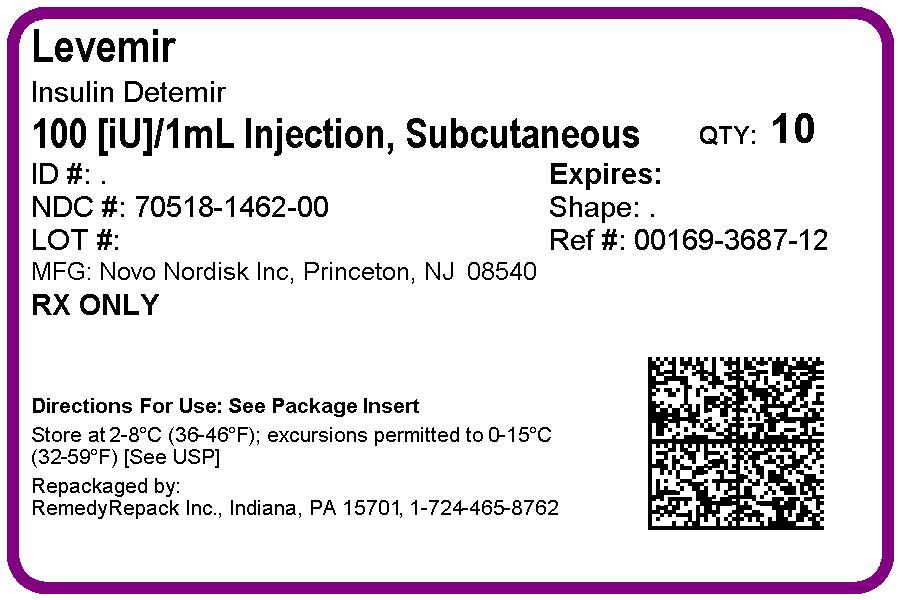
-
INGREDIENTS AND APPEARANCE
LEVEMIR
insulin detemir injection, solutionProduct Information Product Type HUMAN PRESCRIPTION DRUG Item Code (Source) NDC: 70518-1462(NDC:0169-3687) Route of Administration SUBCUTANEOUS Active Ingredient/Active Moiety Ingredient Name Basis of Strength Strength INSULIN DETEMIR (UNII: 4FT78T86XV) (INSULIN DETEMIR - UNII:4FT78T86XV) INSULIN DETEMIR 100 [iU] in 1 mL Inactive Ingredients Ingredient Name Strength HYDROCHLORIC ACID (UNII: QTT17582CB) GLYCERIN (UNII: PDC6A3C0OX) 16 mg in 1 mL METACRESOL (UNII: GGO4Y809LO) 2.06 mg in 1 mL PHENOL (UNII: 339NCG44TV) 1.8 mg in 1 mL SODIUM CHLORIDE (UNII: 451W47IQ8X) 1.17 mg in 1 mL SODIUM HYDROXIDE (UNII: 55X04QC32I) ZINC (UNII: J41CSQ7QDS) 65.4 ug in 1 mL SODIUM PHOSPHATE, DIBASIC, DIHYDRATE (UNII: 94255I6E2T) 0.89 mg in 1 mL Packaging # Item Code Package Description Marketing Start Date Marketing End Date 1 NDC: 70518-1462-0 1 in 1 CARTON 10/04/2018 1 10 mL in 1 VIAL, GLASS; Type 0: Not a Combination Product Marketing Information Marketing Category Application Number or Monograph Citation Marketing Start Date Marketing End Date NDA NDA021536 10/04/2018 Labeler - REMEDYREPACK INC. (829572556)
Trademark Results [Levemir]
Mark Image Registration | Serial | Company Trademark Application Date |
|---|---|
 LEVEMIR 76468735 2808088 Live/Registered |
Novo Nordisk A/S 2002-11-07 |
© 2025 FDA.report
This site is not affiliated with or endorsed by the FDA.

